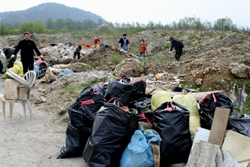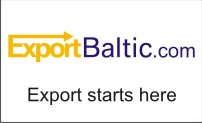Ecology, EU – Baltic States, Legislation, Markets and Companies
International Internet Magazine. Baltic States news & analytics
Sunday, 31.08.2025, 08:50
Municipal waste management in EU strives for urgent solution
 Print version
Print version |
|---|
The resulting scoreboard forms part of an on-going study that will help EU states improve their waste management performance. Top of the table are Austria, Belgium, Denmark, Germany, the Netherlands, and Sweden, none of which have more than 2 red flags. But the pattern is reversed at the other end of the scale, where green flags are scarce.
A study prepared for the Commission estimates that full implementation of EU waste legislation would save €72 billion a year, increase the annual turnover of the EU waste management and recycling sector by €42 billion and create over 400,000 jobs by 2020 (details are available on the Commission’s website).
Commission’s opinion
Upon delivering the report, the EU Environment Commissioner Janez Potočnik underlined that the report’s result “confirms Commission’s strong concern”.
Many EU member states are still land filling huge amounts of municipal waste, which is the worst waste management option – despite better alternatives and despite structural funds being available to finance better options.
The Commission is of the opinion that on “land filling-mode” valuable resources are being buried, potential economic benefits are being lost, jobs in the waste management sector are not being created, and human health and the environment suffer. “This is hard to defend in our present economic circumstances, concluded the Commissioner.
Reference: Press Release, IP/12/888; 7 August 2012.
Unfortunate results for the Baltic States
The EU states with the largest implementation gaps are Bulgaria, Cyprus, the Czech Republic, Greece, Italy, Malta, Poland, Romania and Slovakia, including 3 Baltic States - Estonia, Lithuania and Latvia). Failings include poor or non-existent waste prevention policies, a lack of incentives to divert waste from landfills, and inadequate waste infrastructure. Heavy reliance on land filling means that better waste management options such as re-use and recycling are consistently underexploited. The outlook is accordingly poor.
Austria, Belgium, Denmark, Germany, the Netherlands, and Sweden by contrast have comprehensive waste collection systems and landfill less than 5% of their waste. They have well developed recycling systems, sufficient treatment capacity, and they perform well with biodegradable waste. Typically, they blend legal, administrative and economic instruments to good effect in their waste management policies, the report underlines.
A number of EU states have made rapid progress from reliance on land filling to its virtual elimination. But even the best performers face a number of challenges such as stepping up waste prevention and addressing overcapacity in the incineration sector, which may hamper recycling and require imports of waste to feed incinerators.
Perspectives
The Commission is using this report to prepare Roadmaps for the ten worst performing member states. These will be discussed with national authorities at bilateral seminars this autumn, starting in Prague on 19 September.
The Roadmaps will help spread best practices and will contain tailor-made recommendations on how to improve waste management using economic, legal and administrative tools, as well as the EU structural funds.
The
Commission is looking to use EU structural funds with a greater focus on the
objectives of EU waste policy. The proposed Multiannual Financial Framework
(MFF) for 2014-2020 will ensure that EU money is only invested in waste
management projects if certain conditions are met beforehand, including the
development of Waste Management Plans in accordance with the Waste
Framework Directive and with the waste hierarchy, favouring prevention,
reuse and recycling over incineration with energy recovery, with land filling
or incineration without energy recovery as a last resort.
For more information:
For the Screening Report, see:
http://ec.europa.eu/environment/waste/studies/pdf/Screening_report.pdf (the scorecard is in colour on page 41)
For more waste studies, see:
http://ec.europa.eu/environment/waste/studies/index.htm and
Eurostat Environmental Data Centre on Waste:
http://epp.eurostat.ec.europa.eu/portal/page/portal/waste/introduction
Commission website on waste management:
http://ec.europa.eu/environment/waste/index.htm
Table: Waste management criteria in full
|
1.1 |
1.2 |
1.3 |
1.4 |
1.5 |
1.6 |
2.1
|
2.2 |
2.3 |
3.1 |
3.2 |
3.3 |
3.4 |
3.5 |
4.1 |
4.2 |
5.1 |
5.2 |
Overall score |
Situation in the 3 Baltic States:
Compared to some other Baltic States (PL- Poland, DK- Denmark, DE- Germany):
Notes for the Table:
1.1 Level of decoupling of municipal waste generation from household final consumption expenditure
1.2 Existence of own waste prevention program (WPP) or equivalent existence in Waste Management Plan or other (environmental) programs
1.3. Amount of municipal waste recycled (material recycling and other forms of recycling including composting)
1.4. Amount of municipal waste recovered (energy recovery)
1.5. Amount of municipal waste disposed (deposit onto or into land and incinerated without energy recovery)
1.6. Development of municipal waste recycling (material recycling and other forms of recycling including composting)
2.1. Existence of nationwide ban/restrictions for the disposal of municipal waste into landfills
2.2. Total typical charge for the disposal of municipal waste in a landfill
2.3. Existence of pay-as-you-throw (PAYT) systems for municipal waste
3.1. Access to waste collection services for municipal waste
3.2. Available treatment capacity for municipal waste in line with the EU waste legislation (including disposal and incineration)
3.3. Forecast of municipal waste generation and treatment capacity in the Waste Management Plan
3.4. Existence and quality of projection of municipal waste generation and treatment in the Waste Management Plan
3.5. Compliance of landfills for non-hazardous waste with Landfill Directive
4.1 Fulfillment of the targets of the Landfill Directive related to biodegradable municipal waste going to landfill
4.2. Rate of biodegradable municipal waste going to landfills
5.1. Number of infringement procedures – Waste Framework Directive and Landfill Directive
5.2. Number of court cases – Waste Framework Directive and Landfill Directive








 «The Baltic Course» Is Sold and Stays in Business!
«The Baltic Course» Is Sold and Stays in Business!

